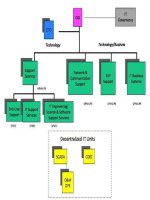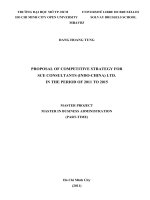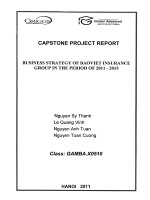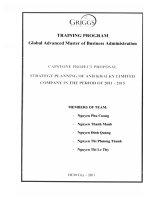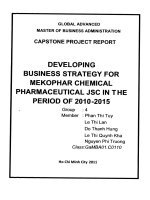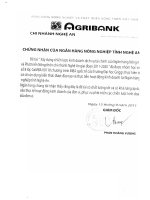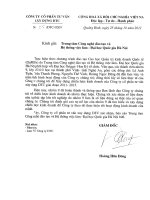Establishing business strategy in the period of 2011 - 2015 at Kien Vuong CO., LTD
Bạn đang xem bản rút gọn của tài liệu. Xem và tải ngay bản đầy đủ của tài liệu tại đây (855.8 KB, 82 trang )
ESTABLISHING BUSINESS STRATEGY
IN THE PERIOD OF 2011-2015
AT KIEN VUONG CO.,LTD
CAPSTONE PROJECT REPORT
Ho Chi Minh City
Group No.: 4
1. Phan Thi My Anh (Ms.)
2. Le Minh Trung (Mr.)
3. Vu Van Trang (Mr.)
4. Nguyen Minh Trung (Mr.)
5. Nguyen Ngoc Son (Mr.)
Class: GaMBA.C03
ESTABLISH BUSINESS STRATEGY IN THE PERIOD OF 2011-2015
AT KIEN VUONG COMPANY LTD
Page 1
TABLE OF CONTENT
LIST OF CHARTS, DIAGRAMS AND REPORTS 6
INTRODUCTION 7
CHAPTER I – THEORETICAL BACKGROUND 9
1. Strategy and strategy management definition 9
1.1 Strategy definitions 9
1.2 Strategic management definitions 10
1.3 The role of strategic management. 11
2. Strategy classification. 11
2.1 Classified according to the management. 11
2.1.1 Corporate level strategy 11
2.1.2 Business level strategy 12
2.1.3 Functional level strategy 12
2.2 Business strategy types 12
2.2.1 General strategy. 12
2.2.2 Unit strategy. 12
3. Strategic management process. 13
3.1 Define the vision-mission and business goals. 13
3.2.1 Research on environment 15
3.2.2 Collecting information 18
ESTABLISH BUSINESS STRATEGY IN THE PERIOD OF 2011-2015
AT KIEN VUONG COMPANY LTD
Page 2
3.2.3 Processing information and formulating strategy 21
3.3 Strategy formation 21
3.3.1 Integration. 21
3.3.2 Matching phase – SWOT matrix analysis 24
3.3.3 Strategy selection phase 26
4. The operation of chemical manufacturing business in Vietnam 28
4.1 Overview of the chemical industry 28
4.2 The development of chemical technologies in Vietnam 28
4.3 The need for the import of chemicals in Vietnam. 29
CHAPTER I SUMMARY 31
CHAPTER II – CURRENT BUSINESS ACTIVITIES OF KIEN VUONG
LIMITED COMPANY 32
1. Development history and business activity of Kien Vuong limited company
32
1.1 Development history 32
1.2 The company’s main activities 33
1.3 The organization’s structure and function 34
1.3.1 Organization Structure 34
1.3.2 Function of each division 35
1.3.3 Infrastructure and technical facilities 36
1.3.4 Operation status in previous stage 37
2. Some issues should be noted in the historical development of the Kien Vuong
Company. 40
ESTABLISH BUSINESS STRATEGY IN THE PERIOD OF 2011-2015
AT KIEN VUONG COMPANY LTD
Page 3
3. Analysis of factors affecting business activities of the Kien Vuong Company
42
3.1 External environment factors 42
3.1.1 Macro-economic 42
3.1.2 Business activities of chemical industry 45
3.1.3 Politics and legal system 49
3.1.4 Culture and society 50
3.1.5 Technology 51
3.1.6 Human resources 51
3.1.7 Competitors 52
3.1.8 Suppliers 53
3.1.9 Customers 53
3.1.10 Alternative products 53
3.1.12 Competition Matrix 55
3.2 Internal factors 56
3.2.1 Management 56
3.2.2 Human resources 56
3.2.3 Technology infrastructure: 56
3.2.5 Kien Vuong’s products: 57
3.2.6 Internal factor matrix 58
CHAPTER II SUMMARY 59
CHAPTER III: BUSINESS STRATEGY FOR THE PERIOD 2011 - 2015 IN
THE KIEN VUONG COMPANY LTD 60
1. Define vision and mission 60
ESTABLISH BUSINESS STRATEGY IN THE PERIOD OF 2011-2015
AT KIEN VUONG COMPANY LTD
Page 4
3. Objectives and key indicators 61
a. Objectives 61
b. Specific targets 61
4.1 SWOT analysis matrix 62
4.1.1 The Opportunities for the company 62
4.1.2 The Threats for the company 63
4.1.3 The Strengths for the company 64
4.1.4 Weaknesses of the company (Weaknesses) 66
4.1.5 SWOT Matrix 67
4.2.1 Group strategy S – O 69
4.2.2 Group strategy S – T 69
4.2.3 Group strategy W – O 69
4.2.4 Group strategy W – T 70
5. Propose measures to implement strategy 70
5.1 Solutions relating to human resources 70
5.2 Marketing-related solutions 72
5.2.1 Chosen market segment 72
5.2.2 Product solutions – services 72
5.2.3 Solution price 73
5.2.4 Distribution solution 73
5.2.5 Solution of promotion 74
5.2.6 Building and brand positioning 75
5.3 Solutions related to the operating organization 75
ESTABLISH BUSINESS STRATEGY IN THE PERIOD OF 2011-2015
AT KIEN VUONG COMPANY LTD
Page 5
5.4 Solutions related to the work of R & D 76
6. Recommendation 77
6.1 Recommendations for State 77
6.2 Recommendations for industry 78
6.3 Recommendations for company 78
CHAPTER III SUMMARY 80
IN CONCLUSION 81
ESTABLISH BUSINESS STRATEGY IN THE PERIOD OF 2011-2015
AT KIEN VUONG COMPANY LTD
Page 6
LIST OF CHARTS, DIAGRAMS AND REPORTS
1. Models of the comprehensive strategic management
Page 14
2. Porter's Five Forces framework
Page 16
3. Elements of competitive analysis
Page 17
4. Organization Structure
Page 34
5. Some basic financial criteria of the Kien Vuong Company in the period
from 2008 to 2010
Page 37
6. Revenue growth graphs through 2008, 2009, 2010
Page 38
7. Revenue structure of Chemical for the areas and sectors in 2010
Page 38
8. Sales of chemicals and materials group achieved in 2010
Page 38
9. Statistics Graphs of Net profit by product in 2010
Page 39
10. Economic growths in Vietnam from 2005 to 2010
Page 43
11. The inflation situation in Vietnam in the period from 2005 to 2010
Page 44
12. The statistics of Vietnam's import turn-over of chemical products in
October and first 10 months of 2010
Page 48
13. Demand for human resource for industries
Page 52
14. External Factor Evaluation (EFE)
Page 54
15. Competition Matrix
Page 55
16. Internal factor matrix
Page 58
17. SWOT Matrix
Page 67
ESTABLISH BUSINESS STRATEGY IN THE PERIOD OF 2011-2015
AT KIEN VUONG COMPANY LTD
Page 7
INTRODUCTION
Nowadays, chemical technology has grown strongly, the needs of chemicals for
production is increasing, according to a recent report by the Department of Chemicals
under the Ministry of Commerce and Industry, the growth rate the chemical industry
will reach an average of 6-7% in 5 years. The forecast growth for the chemical
industry is a good and optimistic signal while the country's GDP growth is also
forecast over 7% from the year 2011-2020; the direct contribution of industry to GDP
in 2011 is expected to reach 2-3%.
However, besides the advantages mentioned above are the threats related to the
low competitiveness of the chemical industry of Vietnam, the competition is
increasing among companies in the industry as the number of active companies in this
field is constantly increasing. Kien Vuong is a new brand in the chemical industry in
Vietnam, therefore to participate in the business environment with many opportunities
but also challenges, company needs to take strategic steps to survive and further
develop in the future. To address that, the business analysts, market research and
evaluation in order to predict the development of the industry to build strategic
business development of Kien Vuong from now to 2015 are essential. That is the
reason that all members in our group agreed to select the topic "Building a business
strategy in the period 2011-2015 at Kien Vuong Co., Ltd" as the subject for our
graduation thesis.
Therefore, the content of the thesis was studied through analysis of business,
understand the need to use chemical products of businesses, the business sector in
Vietnam economy; research on activities of some companies and industries and
competitors to develop business strategies for Kien Vuong Company.
ESTABLISH BUSINESS STRATEGY IN THE PERIOD OF 2011-2015
AT KIEN VUONG COMPANY LTD
Page 8
Subjects of the study include: (1) The economic sectors Vietnam have the
demand for chemicals, (2) The competitors in the industry, (3) Other information
sources: the handout materials, reports of the company, reports the study of relevant
agencies; articles and forecasts on the media, the electronic news.
The research methodologies using in this thesis include synthetic methods,
statistics of secondary data, and quantitative analysis method.
The thesis includes an introduction and three chapter organized as following:
- Introduction.
- Chapter 1: Theoretical background.
- Chapter 2: Current business activities of Kien Vuong limited company
- Chapter 3: Business strategy in the period of 2011-2015 at Kien Vuong
company limited
With limited capability, mistakes cannot be avoided in this thesis. We are
looking forward to your input from teachers, lecturers, colleagues and friends in order
for the completeness of the thesis.
Sincere thanks to the dedicated guidance of Dr. Le Van Bay, the involvement
of student groups of classes C03, Kien Vuong Company Limited director board, so
that we are able to complete the thesis in timely manner.
ESTABLISH BUSINESS STRATEGY IN THE PERIOD OF 2011-2015
AT KIEN VUONG COMPANY LTD
Page 9
CHAPTER I – THEORETICAL BACKGROUND
1. Strategy and strategy management definition
The definition of strategy and strategy management varies from one researcher
to the other; therefore in the scope of this thesis we want to present some of the
common definitions about strategy and strategy management as following:
1.1 Strategy definitions
According to Johnson and Scholes: Strategy is the direction and scope of an
organization over the long-term: which achieves advantage for the organization
through its configuration of resources within a challenging environment, to meet the
needs of markets and to fulfill stakeholder expectations
In other words, strategy of an organization is defined to answer the following
questions:
- Where is the business trying to get to in the long-term? (direction)
- Which markets should a business compete in and what kinds of activities are
involved in such markets? (markets; scope)
- How can the business perform better than the competition in those markets?
(Advantage)?
- What resources (skills, assets, finance, relationships, technical competence, and
facilities) are required in order to be able to compete? (Resources)?
- What external, environmental factors affect the businesses' ability to compete?
(Environment)?
According to Michael Porter (1996): Strategy is the process of harmonizing an
organization’s activities. The success of a strategy depends on the synchronizing many
ESTABLISH BUSINESS STRATEGY IN THE PERIOD OF 2011-2015
AT KIEN VUONG COMPANY LTD
Page 10
activities and matching them with each other, the essence of the strategy is the choice
of what haven’t been done. With this approach, strategy is the creation of competitive
advantages through what haven’t done. The strategy just exists in unique activities.
The objective of an overall corporate strategy is to put the organization in a unique
position with unique activities.
According to Fred David: Strategy is the tool to achieve the long-term goal.
Business strategy can include the following: expanding the territory, diversifying the
products, ownership of product, develop product, penetrating market, reduce cost,
partnership.
1.2 Strategic management definitions
According to Fred David: Strategic management can be defined as an art and
science of formulating, implementing, and evaluating of cross-functional decisions
that enable an organization to achieve its objectives. According to the definition, the
strategic management includes three steps: Strategy formulation, strategy
implementation and strategy evaluation. Strategic management focuses on the
administration, marketing, finance, production, research and development,
information system in the business to achieve the objectives of the organization.
According to Alfred Chandler: Strategic management is the process of defining
the basic long-term goals of the organization, choosing the course of action and
allocating the essential resources to achieve the organization’s goals.
According to John Pearce and Richard B. Robinson: Strategic management is
the system of decision and action to formulate and implement the plan in order to
achieve the organization’s goals.
According to the above definitions, the strategic management has a strong
relationship with the following three important questions:
- What are the objectives of the organization?
ESTABLISH BUSINESS STRATEGY IN THE PERIOD OF 2011-2015
AT KIEN VUONG COMPANY LTD
Page 11
- What are the most effective processes to achieve the objectives?
- What kind of resources needed and how to allocate resources during the
implementation of the plan?
1.3 The role of strategic management.
The strategic management enables organizations to formulate its objectives and
direction;
Strategic management enables the administrator to capture and utilize the
opportunity while minimize the risk involved in the ever-changing business
environment;
By using strategic management, organization will always base the decision
with the relevant environment conditions.
2. Strategy classification.
2.1 Classified according to the management.
Strategic management can present in many level of an organization, in general
there are 3 strategic levels as following:
2.1.1 Corporate level strategy
Corporate level strategy is the guideline for the decision for the whole
institution, and fundamentally concerned with the selection of objectives and the
businesses in which the company should compete to create the basic policy and plan
to achieve the corporate goals.
Corporate level strategy is to select the businesses in which the company
should compete and manage the coordination of businesses portfolio
ESTABLISH BUSINESS STRATEGY IN THE PERIOD OF 2011-2015
AT KIEN VUONG COMPANY LTD
Page 12
2.1.2 Business level strategy
At this business level strategy, the strategy involves with the sustaining the
competitiveness in a specific market, and the adjusting the strategic decision with the
selection of products, meeting the customers satisfaction, positioning the business
against rivals and creating new opportunities.
The strategy at the unit level is the process at which each business unit
manages to achieve its objectives and contribute to the achievement at the corporate
level.
2.1.3 Functional level strategy
The functional level strategy focus on the implementation of business processes
at functional level like marketing, finance, operations, human resources, and R&D and
the development and coordination of resources.
2.2 Business strategy types
Based on the scope of the strategy, we can classify business strategy into 2
types:
2.2.1 General strategy.
The general strategy or overall strategy usually refers to the important, long-
term, visional issues. The general strategy decides the critical issues of the corporate.
2.2.2 Unit strategy.
Unit strategy is the secondary strategy, it usually contains: product strategy,
price strategy, distribution strategy, communication strategy …
The general strategy and unit strategy incorporate with each other to become
the complete business strategy. The business strategy cannot be complete without the
unit strategy which expresses by an objective and each objective is expressed by a
specific criteria.
ESTABLISH BUSINESS STRATEGY IN THE PERIOD OF 2011-2015
AT KIEN VUONG COMPANY LTD
Page 13
3. Strategic management process.
3.1 Define the vision-mission and business goals.
Every organization has a purpose and a reason to exist. The existence of an
organization is well represented by its vision and mission. A recent research by
Fortune magazine about 500 most profitable companies shows that those with a better
overall mission are the ones gain more profit .
1
The vision of an organization should have the following content:
- “The corporate vision is a concise, encouraging statement looking forwards to a
successful future. The statement often reflects high competitiveness of the
company. The vision statement mentions about the overall vision and the
positioning of the corporate towards the future. The vision statement is the image
of the corporate that has specific goal before deciding the processes and actions to
achieve that goal. The vision statement describes the desire for the future but not
necessary needs to show the tools to achieve the final objective.
2
- “Mission statement represents the corporate vision in the written form. It presents
the direction and objective of the corporate. And the business mission is the setting
of priorities, strategies and distribution of work”.
3
- Defining the objectives is to identify each individual object or business results that
the corporate wants to achieve. Objectives derived from the mission must be
separated and more specific
4
1 Fred R. David – Introduction to strategic management –Thong Ke publishing house–2006”.
2 Trần Trí Dũng -
3 Trần Trí Dũng -
4 Nguyễn Thị Liên Diệp, Phạm Văn Nam; “Chiến Lược và Chính Sách Kinh Doanh”; Thong Ke
publishing house, 2003.
ESTABLISH BUSINESS STRATEGY IN THE PERIOD OF 2011-2015
AT KIEN VUONG COMPANY LTD
Page 14
Source: Fred R. David-Strategic Management Book-Francis Marion University
Florence, South Carolina.
Implement external
control to identify
opportunities
Set up
long-term
goals
Set up
annual
goals
Define
vision,
mission
and
strategic
goal
Review of
business
objectives
Distributi
on of
resources
Measure
and
evaluate
the
implemen
tation of
strategies
Implement
internal controls
to identify the
strengths and
weaknesses
Choice
the
strategy
to follow
Give
the
policies
Feedback
Formation of
strategy
Implement
the strategy
Assess the
strategy
Chart: Models of the comprehensive strategic management
ESTABLISH BUSINESS STRATEGY IN THE PERIOD OF 2011-2015
AT KIEN VUONG COMPANY LTD
Page 15
3.2 Study on environment – Collect and process information
3.2.1 Research on environment
The study on the environment to gather and process information is considered
the most important factor at the beginning of the process to build a strategic
management. The elements of a business environment include the following
3.2.1.1 Macro-environment of the corporate:
- Economic factor: Factors affect the business are interest rates, economic cycle
period, the balance of payments, fiscal policy and monetary policy.
- Government and law factors: These factors have growing impacts on business
activities. Businesses must comply with the regulations on hiring, lending, security,
pricing, advertising, plants location and environmental protection…
- Natural factors: The factors that affect business are pollution, lack of energy,
wasteful use of natural resources and increasing demands on resources from nature.
These factors make the strategic manager need to change the decision and
implementation of measures.
- Science and technology factors: more advanced technology is developed will
directly affect the business environment of corporate, creating opportunities and risks
for all industries and businesses. The advent of new technologies will create pressure
for traditional production process; make its products become obsolete. Thus, it
requires corporate to change its technology to improve competitiveness in the market.
3.2.1.2 Corporate micro-environment:
Corporate micro-environment is the external forces that determine the nature of
the competition in the business environment. Applying the Porter's Five Forces
framework to analyze the business strategy enable the business administrator
recognizes the competitive factor that directly affects the corporate.
ESTABLISH BUSINESS STRATEGY IN THE PERIOD OF 2011-2015
AT KIEN VUONG COMPANY LTD
Page 16
Diagram 1-1: Porter's Five Forces framework.
ESTABLISH BUSINESS STRATEGY IN THE PERIOD OF 2011-2015
AT KIEN VUONG COMPANY LTD
Page 17
Diagram 1-2: Elements of competitive analysis.
- Buyer: The patronizing of the customers is the advantage of the company.
However, the bargaining power of customers, the ability of customers to put the
company under pressure which can reduce the company’s profit as well as requires
the company to offer more service.
- Suppliers: The bargaining power of suppliers also put the company under
pressure. Suppliers are supplying raw materials, components, labor, and finance.
What do competitors
want to achieve?
Future direction
At all levels of
administration
What competitors can do
and able to do
Current strategy
How does the competitor
compete currently?
Issues need to answer about
the competitor
- Do competitors satisfy with
the current business?
- What is the possibility that
the competitor has a shift in
their strategy?
- What is the weakness of the
competitor?
- Which factor could help the
competitor to retaliate?
Conclusion
The effects towards
the industry
Potentials
Both strengths and
weaknesses
ESTABLISH BUSINESS STRATEGY IN THE PERIOD OF 2011-2015
AT KIEN VUONG COMPANY LTD
Page 18
- Potential entrants: The entrance of new rivalry will be a factor to decrease the
company’s profit, because they introduce new production method with the hope to
gain more market share and necessary resources.
- Alternatives: The pressure of the existence of alternative products will reduce the
potential profit of the company due to the limitation in the product pricing.
3.2.2 Collecting information
The collecting and processing information is the most important requirements
in the in the process of strategy formulation. The process of gathering information is a
prerequisite to formulating strategies and decisive to the success or failure of the
strategy. If the collection of information is biased it will lead to incorrect decisions
ineffective strategies.
In order to effectively collect information and ensure the accuracy, the
collecting process need to limit the scope of information for formulating strategies and
identify ways to collect information efficiently and accurately. The information
needed for the strategy formulation include:
3.2.2.1 Collecting external environment information:
The external environment information needed to collect includes:
- Political environment in which the companies are or will be working to understand
the political institutions, political parties, legal system, political risks.
- Economic environment in which the companies are or will be working to understand
the economic situation in the market such as GDP, GDP per capita, wage policies,
unemployment situation, inflation, insurance.
- The regulatory environment in which the companies are operating in: to understand
the legal system and consider the possibility of collaboration that the company can
accept and operate business.
ESTABLISH BUSINESS STRATEGY IN THE PERIOD OF 2011-2015
AT KIEN VUONG COMPANY LTD
Page 19
- Services environment and infrastructure in which the companies are working to
understand the situation of infrastructure, technology, financial services in places of
business.
- The cultural environment in which the companies are working to understand the
cultural characteristics of consumers in the market for the products and services that
the company is providing.
- Thorough understanding about the population environment in which the company is
working; about population, age, marital status, ethnicity, thereby determines the size
of the market.
- Understanding of the technology environment in which the company is operating, to
explore the possibility of technology in the place where the business is taking place.
- Understanding the business sector environment in which the company is operating,
how is the sector doing? Is there any support for the industry or not?
- Understanding the vendor environment in which the company is operating, to have
the knowledge about the supplier as the capability, reputation and potential.
- Customer consumption trends.
- Understanding about the competitors, strategy and SWOT of key competitors to gain
the knowledge about the main competitors, potential competitors, and their ability to
finance, human resources, organizational structure, strengths, weaknesses,
opportunities and challenges of competition, the strategies that competitors are and
will be applied.
ESTABLISH BUSINESS STRATEGY IN THE PERIOD OF 2011-2015
AT KIEN VUONG COMPANY LTD
Page 20
3.2.2.2 Collecting internal environment information:
The collecting internal environment information includes the following:
- Planning: including all administrative activities related to preparing for the future.
The specific tasks are: prediction, goals setting, formulating strategies, developing
policies and establish goals.
- Organizing: The structure and governance model of the organization: clearly defined
governance structure of company, authorization
- Leadership: efforts to position the activities of human resources, namely leadership,
communication, working groups, shifting activities, improving the quality of work,
job satisfaction, meeting demand, organizational change, employees' mental and
emotional condition and managerial spirit.
- Control: relating to all management activities to ensure the results match reality,
consistent with the planned results.
- Information system: understanding the management of company’s information
system
- Technology: the ability to grasp and apply technology of the company.
- Human resources: knowledge and skills of staff and employees of the company.
- Marketing: the process of identifying, forecasting, setting and meet the needs of the
consumer desire for products or services; research on marketing environment to
identify market opportunities, market segment, select targeted markets and market
positioning.
- Financial resources: the financial capability of company.
- Strengths: the strengths of the company.
ESTABLISH BUSINESS STRATEGY IN THE PERIOD OF 2011-2015
AT KIEN VUONG COMPANY LTD
Page 21
- Weaknesses: weaknesses of the company.
- Opportunities: opportunities for company.
- Challenges: current and future challenges.
The collection of the above information is done in various forms such as
reports and feedback from the various departments, from financial reports, from
media, from state management agencies, from trade counselors, from the auditing
firm, from market survey companies, from the association, from market surveys.
3.2.3 Processing information and formulating strategy
From the collected data, the strategists will take steps to process, analyze and
formulate strategies from which to choose one or the most appropriate strategy to put
in implementation. In the process of analyzing the data collected to formulate strategy,
the following contents need to be done: Strategy formation phase.
3.3 Strategy formation
3.3.1 Integration.
Integration process (phase 1 of the strategy formulation process) is the period
to analyze environmental factors and internal factors of the organization to build the
matrices: the external factor evaluation matrix (EFE), competition profile matrix,
internal factor evaluation matrix (IFE).
3.3.1.1 External factor evaluation matrix (EFE) analysis
The External Factor Evaluation Matrix (EFE matrix) is the strategic tool used
to evaluate firm existing strategies, EFE matrix can be defined as the strategic tool to
evaluate external environment or macro environment of the firm include economic,
social, technological, government, political, legal and competitive information. The
EFE matrix consists of following attributes:
ESTABLISH BUSINESS STRATEGY IN THE PERIOD OF 2011-2015
AT KIEN VUONG COMPANY LTD
Page 22
(1) Identify a list of KEY external factors that affect the success of the company
which have been identified in the process of analyzing the external factor including
the opportunities and threat towards the company.
(2) The importance level: Assign the importance classification of 0.0 (not
important) to 1.0 (very important) for each element. This classification shows the
importance of the corresponding elements for success in the business of the company.
The total number assigned to these factors classification levels must be equal to 1.0;
(3) Assign a 1-4 rating to each critical success factor to indicate how effectively
the firm’s current strategies respond to the factor. In which 4 = response is extremely
good, 3 = response is above average, 2 = response is average, 1 = response is poor.
(4) Multiply each factor’s weight by its rating to determine a weighted score
(5) Sum the weighted scores to specify the total score for the company.
Regardless the major opportunities and the threat included in the EFE matrix,
the sum of all weighted score is equal to the total weighted score, final value of total
weighted score should be between range 1.0 (low) to 4.0(high). The average weighted
score for EFE matrix is 2.5. The total weighted score of 4.0 shows good response of
the company with the current opportunity and threat in the envireonment. While the
total weighted score of 1.0 shows that the current strategy is not able to utilize the
opportunity or avoid threat from external environment.
3.3.1.2 Competition profile matrix
Competitive profile matrix is an essential strategic management tool to
compare the firm with the major players of the industry. Competitive profile matrix is
the expansion of the EFE matrix in which measure the same critical success and same
meaning on the total weighted score as well as the assigning score. The CPM score of
the rival company is compared with the sample company. This type of analysis
provides valuable strategic information for the company.
ESTABLISH BUSINESS STRATEGY IN THE PERIOD OF 2011-2015
AT KIEN VUONG COMPANY LTD
Page 23
The external factor evaluation matrix and competitive profile matrix enable
strategists to evaluate the business environment. However, this tools need to be
accompanied by intuition evaluation.
The formation of the competitive profile matrix is almost the same as that of
the external factor evaluation matrix.
3.3.1.3 Internal factor evaluation matrix analysis.
IFE (Internal factor evaluation) matrix is one of the best strategic tools for internal
audit of functional area of business like company strength, weakness, finance,
marketing, IT, operations, accounts, human resources. There are five steps in
developing the IFE matrix:
1. List key internal factors as identified in the internal audit process. Use a total
of from ten to twenty internal factors, including both strengths and weaknesses. List
the strengths first and then weaknesses.
2. Assign a weight that ranges from 0.0 (not important) to 1.0 (all important) to
each factor. The weight assigned to a given factor indicates the relative importance of
the factor to being successful in the firm’s industry. Regardless of whether a key
factor is an internal strength or weakness, factors considered to have the greatest effect
on organizational performance should be assigned the highest weights. The sum of all
weights must equal 1.0.
3. Assign a 1 to 4 rating to each factor to indicate whether that factor represents
a major weakness (rating = 1), a minor weakness (rating = 2), a minor strength (rating
= 3), or a major strength (rating = 4). Note that strengths must receive a 4 or 3 rating
and weaknesses must receive a 1 or 2 rating. Ratings are thus company based, whereas
the weights in Step 2 are industry based.
4. Multiply each factor’s weight by its rating to determine a weighted score for
each variable.
ESTABLISH BUSINESS STRATEGY IN THE PERIOD OF 2011-2015
AT KIEN VUONG COMPANY LTD
Page 24
5. Sum the weighted scores for each variable to determine the total weighted
score for the organization. Final value of total weighted score should be between
ranges 1.0 (low) to 4.0(high). The average weighted score for IFE matrix is 2.5 any
company total weighted score fall below 2.5 consider as weak. The company total
weighted score higher than 2.5 is consider as strong in position.
3.3.2 Matching phase – SWOT matrix analysis
- Integration phase (phase 2 of the strategy formulation process) is the important stage
of the process of forming a strategy in the most basic way, at this stage all the data has
been collected, analyzed at the integration stage will be developed further through the
establishment of more complex matrices such as BCG Matrix, SPACE Matrix and
SWOT matrix (matrix analysis of the opportunities, threats, strengths and
weaknesses).
- SWOT matrix analysis:
The SWOT matrix analysis aims at defining the Strength (S), Weakness (W),
Opportunities (O), and Threats (T) from the business environment, therefore an
appropriate strategy can be proposed to mitigate the weakness and strengthen the
strengths, and control the threats.
The SWOT matrix is the integration tool that can help the strategist to develop
the following 4 strategies:
- Strengths and Opportunities (SO) strategy – use our strengths to take
advantage of the opportunities
- Weaknesses and Opportunities (WO) strategy –use our opportunities to
overcome the weaknesses experiencing
- Strengths and Threats (ST) strategy –take advantage of our strengths to
avoid real and potential threats
